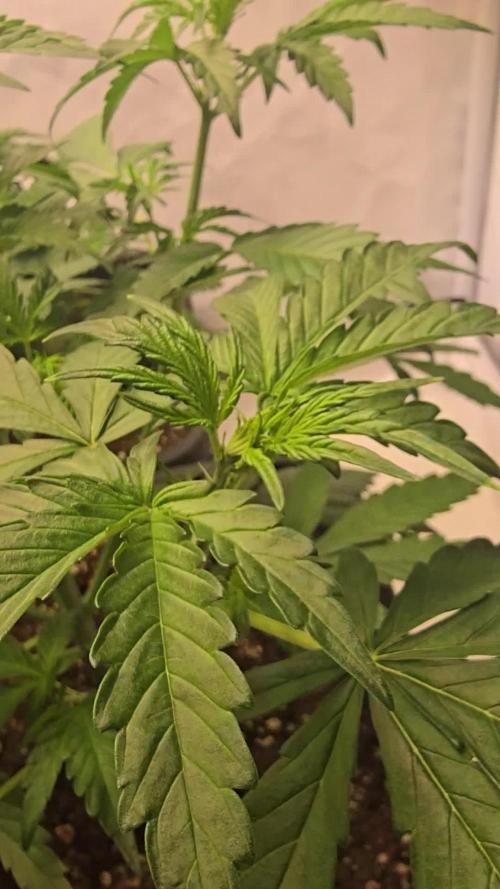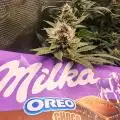The Grow Awards 2026 🏆 





































Likes
Comments
Share


@Weedman268
Follow
Really love this strain, grown it a few times, happy with how she turned out, greasy an sticky and the smoke is heavy an euphoric, she smells like fruit punch with hints of nut meg, a smell I can't explain very pungent...
Likes
8
Share


@BlazingAngel420
Follow
I am now 100% positive I know the strains that are growing within my little jungle. I believe I have 4 purple lemonade, 3 Gelato autos, and 1 strawberry banana auto. And Am extremely happy that I could finally identify them all. I've got 1 feminised sour strawberry and 1 the wolf germinating at the moment hoping they take off and I can start my new adventures. Happy growing my fellow weedlings 🌳🥦🌸.
Likes
27
Share


@Dunk_Junk
Follow
Wow she's grown 24cm this week.
I'm getting excited about her! I think she's looking to be a fab plant.
Doing well in her fabric pot.
Likes
11
Share


@Tye91
Follow
So I accidentally erased my other journal so I restarted it with this. This week has been great she's frosting really nice getting fatter everyday and I will be flushing her on Wednesday. (Almost There)
Processing
Likes
Comments
Share


@absolutgrow
Follow
Dear Grow community,
The three RG automatic have grown very well and have so far no complaints. They love the temperature and dont need much water. They have grown very fast and already have a light smell.
Likes
17
Share


@gottagrowsometime
Follow
Runtz Female 7Lpot & 7 weeks. Ready to clone in the next few days.
Week 7 of the Green Sensation test. Mother plant is growing at an extremely low rate, its focus was on leaf growing so over the week. I starting removing and the plant is starting to take shape. I think I'll be able to grab a nice pair of clones in 5-7 days.
Days 42-46
Slowly over the past few days. I took all of the fan leaves off 1 set a day. Kept the feed low to not stress her. Hopefully I can get 2 good clones. Keeping everything simple as stated in the past few weeks. (If you want more info read back.)
Ppm kept between 3-350 and master root, etc. All detailed in detail.
Day 47-48
Plant has finally started growing its nodes. The two top ones are ready to go. didn't remove any leaves. I'll veg this for 4 more weeks and flip. As I've said before. This one will be kept on Xpert Nutrients.
Day 49
Pheno is doing well. Amazing growth the past 24 hrs. She's coming into a real stride. I'll take 2 clones ready to start the Green Sensation
Day 50 2x clones have been removed.
20% off Zamnesias entire catalogue of seeds:ZAMMIGROW2024
20% off XPERT NUTRIENTS/KANNABIA with code:GGST
20% off Oringal Sensible Seeds with code:
Likes
7
Share


@CanarianGrow92
Follow
1st of august, still quite hot, we gave the plant some water but kept her on the balcony, this plant grows fast AF, we didn't even start to feed the girl but it seems that the mycorrhizae and bio enhancer did a great job
2nd August, nothing
3rd August water
4th August moved plant to the roof (original location)
5th august water
6th and 7th August maybe we give a very small shot of iguana grow and ancient Earth
Likes
4
Share


@Big0zGrower420
Follow
Day 42
Just trying to pull through till harvest. Got a couple more weeks to go.
Likes
21
Share


@Dapper_Buds
Follow
What’s going on lady’s an gentleman. we got the Moab strains going on W/1 in living soil. They where planted into the root riot cube an treated with neem oil to kill off the fungus gnats, they are thriving now. An getting bigger as the day goes. They will be trans planted into the auto pot system at end of this week. Into the 2x4. Under the double UFL3000 mounted on custom frame. Pumping 402w from the wall. Currently both the girls are in the veg/solo cup cabinet under the UF2000 100w light. Currently 60% rh and temps running 79 lights on. Thanks for viewing an happy growing!
Processing
Likes
15
Share


@donovanliam
Follow
Pictures are gonna suck till I get an actual camera my phones camera.. just got CALiMAGic and diamond nectar. So I'm looking forward to see how she likes it . Updated to come
Likes
5
Share


@SkunkyDog420
Follow
Hallo zusammen 🤙
Sie wächst sehr schön und macht keine Probleme.
Wer einen Rabatt von 20 % haben möchte muss den Code: ZAMMIGROW2024 eingeben.
Likes
22
Share


@PhotonMan
Follow
04/02 500ml of water each pot, PH 5.82, nutrients as described into schedule
04/03 --
04/04 --
04/05 --
04/06 500ml of water, PH 5.92, nutrients as described into schedule
04/07 --
04/08 250ml of pure water each pot, PH 5.8. I've also defoliated #3 and removed dead leaves from #1 and #2
Likes
3
Share


@ThatsmyGrow
Follow
This week is special, i got the New System from ac infinity. I need to get comfort with everything, but its realy high Qualität.
For now we can get the best vpd for the lady, so i hope the best for the flower.
Likes
126
Share


@love_2_grow
Follow
D18 - Today was the first day in week three of veg, and it was time for transplanting the girl into her final pot. All I did was get her out of her cup, sprinkle some mycorhizal inoculant on her roots, and then plant her back into the pot. Finally, I gave her around 1.2-liters of water @ pH 6.4 to reduce transplant shock.
D20 - Not much to report, but she is looking happy after the transplant. I gave her about 0.6-liters of water @ pH 6.5 just because I had some over from watering the Colorado Cookies girl. Overwatering a single time should be fine.
D22 - She is loving her new home, looking vibrant and healthy. I cut down the cover crop as it was getting a bit unruly.
D23 - I opened the tent today and realized I forgot to fill up the humidifier last night. The RH in the tent was only 29%. Oops!
I gave the girl about one liter of compost tea that I started brewing yesterday.
24 - The end of the third week of veg and she is loving life after her transplant. She is 9 cm tall and 13 cm across and has grown sturdy enough to start LST next week.
Processing
Likes
10
Share


@Trying4Trees
Follow
Week 1 - Day 1
20L Super Air Pots with a bottom layer of clay pebbles, (an inch deep at the centre point) and topped off with Growdog’s 70/30 coco perlite mix.
The tops of the pots are covered by green plastic water distributers to evenly spread the water from the 12” watering rings.
2 lights; each 300W actual draw, currently inside the tent. 2 more coming next week to make a total of 4, across the 6 plants achieving a true watt draw of 1200W.
Aiming for 1g/watt
Germinated seeds from FAST BUDS, were planted and hand watered using tap water pH’d to high 5.8 to low 5.9 with H&G Roots Excl. giving a nice PPM of 362 to start.
The BudBox tent is a 2x2x2m, using a Medusa Boosted XL run off trays to a waste brain were the run off can be tested. This will then be recirculated into the feeding tank again. The feed tank will a standard 100L water butt, retro fitting pumps inside for Feeding and Pump to waste - for cleaning the tank out each week. Another 100L water butt will contain a store of filtered RO water which will fill the feeding tank.
A 10L PureMate humidifier is set at 65%, along with 2x RAM 16” oscillating wall fans which are mounted to the top of the tent for maximum coverage - set to lvl1 on swing giving the 25°C. No extraction yet. This is ready and waiting. 8” HyperFresh fan with a RHINO 8”x600 pro filter. We are using 8” acoustic ducting.✌️🏻
Week 1 - Day 2
No change. Keeping the new environment stable is difficult. The humidifier is not large enough for the space.
Week 1 - Day 3
Fed PH RO water this morning. Trying to keep the humidity up inside the tent.
They have popped up! It begins :D
Did a feed of 5.8PH RO with CocaA&B 0.4ml/l, Roots excl 0.3ml/l, Calmag 0.2ml/l for a 150PPM. 300ml was used to moisten the coco per pot.
Extraction fully connected. Environment stable at 23-24°C, trying to stay at 23.3°C. Humidity fluctuating 47-60%, humidifier struggling, but hopefully be okay.
Week 1 - Day 4
All 6 are up and reaching. Husks hopefully will pop off soon. Will be doing another small feed this evening to keep the coco moist.
Little leaves have appeared!! Fed another 300ml, 5.8PH @ 151PPM/ plant.
Week 1 - Day 5
All shooting up now, tallest at 5cm down to 3.5cm 🌱
I gently helped the last 2 husks off the smallest ones to hopefully even them up. Gave the coco 1L of RO water around the edges.
Week 1 - Day 6
Nothing to report this morning. Another PPM feed to be done shortly.
Soaked the coco until run off with around 3-4L per pot using 5.8PH nuit water; 0.4 Canna A&B, 0.2 Calmag, 0.3 Roots Excl. 152PPM.
First time we tested the Medusa brain - works well and pumps away to the feed tank, need to change one of the low trays to be a boosted tray for better drainage. Giving 5 boosted trays and one normal. Hand feeding up until this point, but will connect up the automation in the next week.
Week 1 - Day 7
Strongest are growing around 1cm a day now. Tallest 6cm, smallest at 4cm. Looking forward to next weeks progress :)
Bought a wet&dry vac - best thing ever!! Haha. Cleans everything in sight plus all the water from the dirty run off.
Lifted all the pots, still a good weight to them so no feed or RO water today I think. Bring on week 2! 💪🏻
Likes
10
Share


@HideAndFly420
Follow
Something wrong happened on the end of last week.
I had a little irrigation problem and I did a m mistake with the fan’s position, it was too direct on the roots.
I think this could have caused a block to the nutrients transmission.
I will give just water with regulator ed enzym+.
Let’ a see
Likes
7
Share


@SkunkyDog420
Follow
Hallo zusammen 🤙.
Sie wächst sehr schön und macht keine Probleme.
Wer einen Rabatt von 20 % haben möchte muss den Code: ZAMMIGROW2024 eingeben
Likes
18
Share


@DevilsBud
Follow
Boom!!!!
New week and Damm there looking fire great smell coming from them all day long couple weeks to go 💪🏻
Likes
24
Share


@Rangaku
Follow
Harvested XL today and spent 5 hours in trim jail , well worth it . My eyes were burning, hands stuck together and the smell filled the house . Prolly looking at about 12-14 oz once dried and I’m gonna smoke it all















